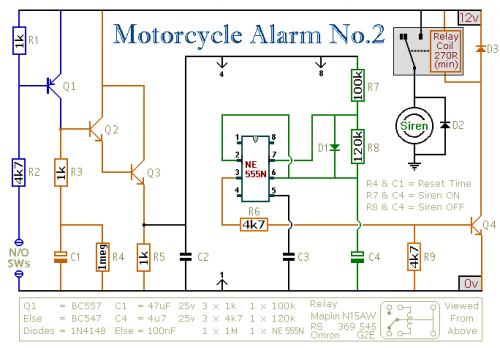This circuit features an intermittent siren output and automatic reset. Can be operated manually with a key switch or a hidden switch, but can also be connected to set automatically when the ignition is turned off. By adding external relays you can immobilize the bike, flash lights, etc. I used Andy asymmetric timer as a basis for this design.
Any number of normally open switches may be used. Fit "tilt" switches that close when the steering is moved or when the bike gets up from his side foot and pushed off center to understand. The use of micro-switches to protect removable panels and the tops of the bags, etc
Standby current of the alarm is virtually zero - so it does not drain the battery. Once activated - the rate at which the siren switches on and off is controlled by R7, R8 and C4. For example, the R7 will increase the longer sound - while increasing R8 offers longer periods silently.
The circuit is designed to use an electronic siren drawing 300 to 400 mA. There is usually a good idea to use the bike's own Horn because it can be easily located and disconnected. However - if you choose to use the Horn - remember that the alarm relay is too small to carry the current required. Connect the coil of a relay capacity adequate to the "Siren" output. This can be used to sound the horn, flash lights, etc.
The circuit board and switches must be protected from the elements. Moisture or condensation caused a malfunction. Connect a 1-amp inline fuse AS close as possible to the power supply. This is VERY IMPORTANT. The fuse is there to protect the wiring - not the alarm. Exactly how the system is fitted will depend on the brand of your particular machine - so I can provide more help or advice.
When the alarm - if one of the switches is closed - the siren will sound. This could cause trouble late at night. A small modification will allow you to monitor the status of switches with LED. When the LEDs are off - the switches are open - and it is safe to activate the alarm.
Any number of normally open switches may be used. Fit "tilt" switches that close when the steering is moved or when the bike gets up from his side foot and pushed off center to understand. The use of micro-switches to protect removable panels and the tops of the bags, etc
Standby current of the alarm is virtually zero - so it does not drain the battery. Once activated - the rate at which the siren switches on and off is controlled by R7, R8 and C4. For example, the R7 will increase the longer sound - while increasing R8 offers longer periods silently.
The circuit is designed to use an electronic siren drawing 300 to 400 mA. There is usually a good idea to use the bike's own Horn because it can be easily located and disconnected. However - if you choose to use the Horn - remember that the alarm relay is too small to carry the current required. Connect the coil of a relay capacity adequate to the "Siren" output. This can be used to sound the horn, flash lights, etc.
The circuit board and switches must be protected from the elements. Moisture or condensation caused a malfunction. Connect a 1-amp inline fuse AS close as possible to the power supply. This is VERY IMPORTANT. The fuse is there to protect the wiring - not the alarm. Exactly how the system is fitted will depend on the brand of your particular machine - so I can provide more help or advice.
When the alarm - if one of the switches is closed - the siren will sound. This could cause trouble late at night. A small modification will allow you to monitor the status of switches with LED. When the LEDs are off - the switches are open - and it is safe to activate the alarm.










